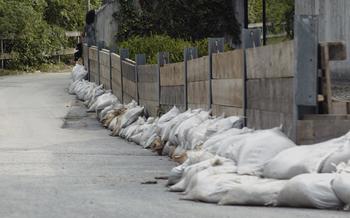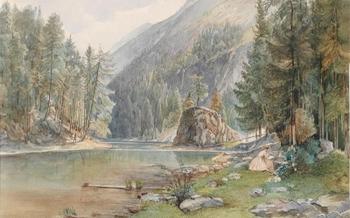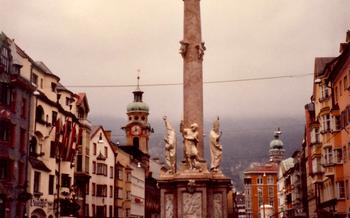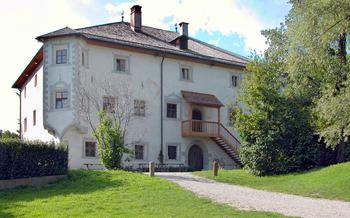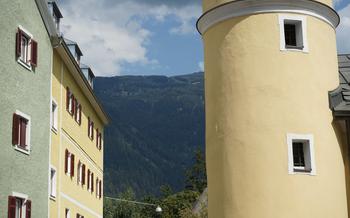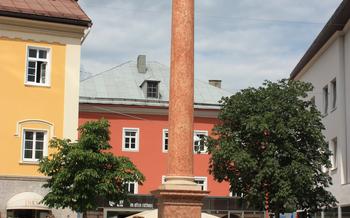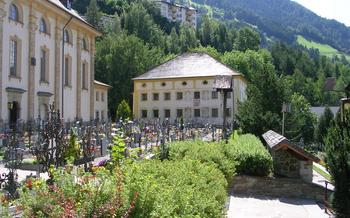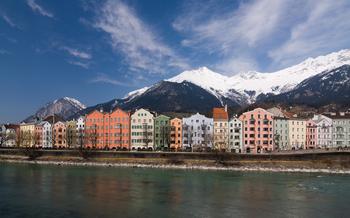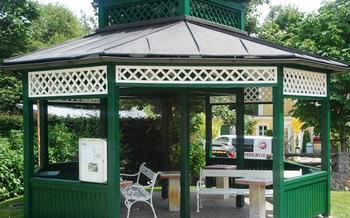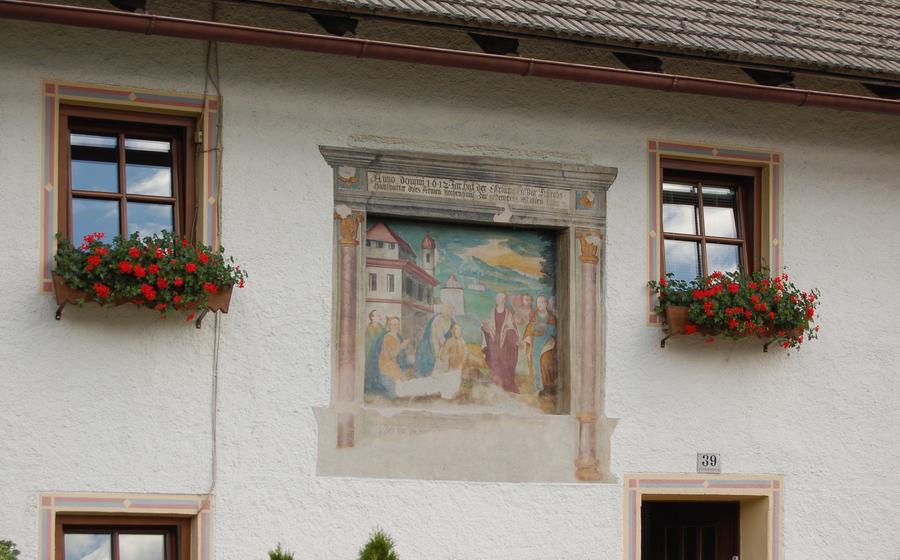
The Parish Church of St. Nicholas in Matrei in Osttirol
- The Parish Church of St. Nicholas in Matrei in Osttirol
- History of the Parish Church
- Architectural Features
- Interior Treasures
- Religious Significance
- Role in the Community
- Things to See and Do
- Historical Context
- Cultural Significance
- Practical Information
- Getting There
- Parking
- Accessibility
- Facilities
- Events and Festivals
- Nearby Attractions
- Local Cuisine
- Insider Tip: Unveiling a Hidden Treasure
The Parish Church of St. Nicholas in Matrei in Osttirol
The Parish Church of St. Nicholas, nestled in the picturesque town of Matrei in Osttirol, Austria, stands as a testament to the region's rich history and enduring faith. Its origins can be traced back to the 13th century, when a small chapel was erected on the site. Over the centuries, the church underwent several expansions and renovations, culminating in the magnificent structure that stands today. The church's Gothic-style architecture, with its intricate stone carvings and soaring bell tower, is a sight to behold. Inside, visitors are greeted by a breathtaking display of frescoes, artwork, and stained-glass windows, each telling a unique story from the Bible or the lives of saints. The church's significance extends beyond its architectural and artistic beauty; it serves as a spiritual and cultural hub for the local community, hosting religious ceremonies, festivals, and events throughout the year.
History of the Parish Church
The Parish Church of St. Nicholas in Matrei in Osttirol holds a rich and storied past. Its foundations were laid in the 13th century, during a period of significant religious and cultural transformation in the region. Initially, a modest chapel stood on the site, serving the spiritual needs of the local community. As Matrei grew in prominence and population, the need for a larger and more elaborate church became apparent.
In the 15th century, a Gothic-style church was constructed, replacing the original chapel. This new structure featured a spacious nave, intricate stained-glass windows, and an imposing bell tower that dominated the town's skyline. Over the centuries, the church underwent several renovations and expansions, each reflecting the changing artistic and architectural styles of the time.
One of the most significant renovations occurred in the 17th century, when the church's interior was adorned with stunning Baroque frescoes. These vibrant and expressive paintings depict scenes from the life of St. Nicholas, the patron saint of the church, as well as other religious figures and events. The frescoes transformed the church's interior into a breathtaking work of art, attracting visitors from far and wide.
Throughout its history, the Parish Church of St. Nicholas has played a pivotal role in the religious and cultural life of Matrei in Osttirol. It has witnessed countless baptisms, marriages, and funerals, serving as a sacred space for the community to gather, celebrate, and mourn. The church has also been a place of refuge and solace during times of war and hardship, providing spiritual guidance and comfort to those in need.
Architectural Features
The Parish Church of St. Nicholas in Matrei in Osttirol stands out for its unique architectural features, blending elements of Gothic and Baroque styles. The exterior of the church is characterized by its imposing bell tower, rising gracefully above the surrounding buildings. The tower features intricate stone carvings and a distinctive onion-shaped dome, adding a touch of grandeur to the church's facade.
The interior of the church reveals a spacious nave, lined with elegant pillars that support the vaulted ceiling. The nave is adorned with beautiful frescoes and artwork, creating a visually stunning atmosphere. The intricate details and vibrant colors of the paintings depict scenes from the Bible and the lives of saints, adding to the spiritual significance of the church.
The church's materials, such as the sturdy stone walls and the finely crafted wood of the pews and altar, contribute to its overall aesthetic and durability. The use of natural materials adds warmth and a sense of authenticity to the church's interior.
Symbolism is also evident throughout the church's architecture. The orientation of the building, with the altar facing east, represents the rising of Christ and the spiritual journey towards enlightenment. The stained-glass windows, with their vibrant hues, depict religious scenes and symbols, inviting contemplation and reflection.
Interior Treasures
The Parish Church of St. Nicholas in Matrei in Osttirol boasts a treasure trove of artistic wonders within its walls. The intricate frescoes adorning the walls and ceiling captivate the eyes with their vibrant colors and detailed narratives. These frescoes depict biblical scenes, the life of St. Nicholas, and various saints, each telling a unique story. The talented artists who created these masterpieces have left a lasting legacy, showcasing their mastery of the art form.
Among the notable frescoes is the depiction of the Last Judgment, which occupies a prominent position on the north wall of the nave. This awe-inspiring fresco portrays the separation of the righteous from the wicked, as angels and demons battle for the souls of humanity. The expressions of joy and despair etched on the faces of the figures add depth and emotion to the scene, leaving a lasting impression on the viewer.
The church also houses several exquisite works of art, including sculptures, paintings, and carvings. These pieces range from delicate wooden carvings that adorn the altars to larger-than-life statues that stand sentinel in the niches. Each artwork tells a story, whether it's the serene countenance of the Madonna and Child or the stoic gaze of a bearded saint.
The stained-glass windows of the church are another highlight, casting a radiant glow upon the interior. These colorful windows depict scenes from the Bible, the lives of saints, and the history of the church itself. The intricate details and vibrant hues of the glass create a mesmerizing effect, transforming the church into a kaleidoscope of light and color.
The main altarpiece of the church is a masterpiece in its own right. Carved from wood and adorned with intricate details, the altarpiece features a central panel depicting the coronation of the Virgin Mary. Flanking this central panel are statues of saints and angels, each contributing to the overall grandeur of the altarpiece. The intricate carvings and the use of gold leaf add to the opulence and majesty of this central feature of the church's interior.
Religious Significance
The Parish Church of St. Nicholas holds immense religious significance for the Catholic community of Matrei in Osttirol. It serves as a spiritual center for the town's residents, providing a place for worship, prayer, and religious ceremonies. The church is dedicated to St. Nicholas, the patron saint of children, travelers, and sailors, who is highly revered in the region.
Over the centuries, the church has been a place of pilgrimage for the faithful, who come to seek blessings and offer prayers to St. Nicholas. The church's reputation for miracles and answered prayers has drawn pilgrims from near and far, contributing to its reputation as a sacred site.
As part of the Catholic Church, the Parish Church of St. Nicholas plays a vital role in the religious life of the community. It hosts regular masses, sacraments, and other religious services, providing spiritual guidance and support to the local parishioners. The church's priests and staff are dedicated to serving the community and fostering a strong sense of faith and belonging among its members.
Role in the Community
Beyond its religious significance, the Parish Church of St. Nicholas holds a pivotal role as a gathering place and focal point for the local community. It serves as a venue for various social events, including concerts, exhibitions, and festivals, fostering a sense of togetherness and camaraderie among the residents of Matrei in Osttirol. The church also acts as a community center, hosting meetings, gatherings, and celebrations that bring people together from all walks of life. Throughout history, the church has been intricately intertwined with local traditions and customs, becoming an integral part of Matrei's cultural identity. It stands as a cornerstone of the community, providing a space for spiritual reflection, social interaction, and the preservation of local heritage.
Things to See and Do
Enrich your visit to the Parish Church of St. Nicholas by engaging in a guided tour. These tours offer an insightful journey through the church's history, architecture, and religious significance. Knowledgeable guides will unveil the stories behind the stunning frescoes, intricate artwork, and symbolic elements that adorn the church. Immerse yourself in the church's rich heritage as you discover hidden details and gain a deeper understanding of its role within the community.
For those who prefer a more independent exploration, self-guided tours are also available. Take your time to wander through the church, admiring the grandeur of its interior and exterior. Be sure to look out for the intricate carvings, the beautifully preserved stained-glass windows, and the impressive altarpiece. Photography enthusiasts will delight in capturing the church's architectural beauty and artistic treasures, although it's important to respect any restrictions or guidelines regarding photography inside the church.
Enhance your experience by combining your visit to the church with other nearby attractions. Take a leisurely stroll through the charming town of Matrei in Osttirol, soaking in its Tyrolean atmosphere and admiring the surrounding Alpine scenery. Discover the region's rich history and culture by visiting local museums, galleries, and historical sites. Whether you prefer to delve into the past, appreciate stunning architecture, or simply relax in the picturesque surroundings, Matrei in Osttirol and the Lienz district offer a wealth of experiences for every traveler.
Historical Context
Matrei in Osttirol, where the Parish Church of St. Nicholas is situated, has a rich and captivating history. It was initially mentioned in records dating back to 827 AD, indicating its ancient roots. Throughout the centuries, Matrei served as a significant trading center due to its strategic location along the Isel River. The town's prosperity was further enhanced by the discovery of silver and copper deposits in the surrounding mountains, leading to the establishment of mining operations.
As part of the County of Tyrol, Matrei experienced the influence of various ruling families, including the Habsburgs, who left their mark on the town's architecture and culture. During the Napoleonic Wars, Matrei faced occupation by French and Bavarian forces, leaving behind a lasting impact on the region's history.
The Lienz district, where Matrei is located, boasts a diverse cultural heritage shaped by its proximity to neighboring countries like Italy and Slovenia. This unique blend of influences can be seen in the local traditions, language, and cuisine.
Tyrol, the broader region encompassing Lienz, is renowned for its breathtaking Alpine landscapes, rich history, and vibrant culture. It played a pivotal role in Austrian history, serving as a borderland between different empires and cultures. The region's strategic importance led to the construction of numerous fortifications, castles, and monasteries, adding to its historical significance.
Located in the heart of Europe, Austria has a rich and complex history that has shaped its cultural identity. From the grandeur of the Habsburg Empire to the challenges of the 20th century, Austria has emerged as a vibrant and diverse nation. Its contributions to art, music, and literature have earned it a place among the world's most culturally significant countries.
Cultural Significance
The Parish Church of St. Nicholas in Matrei in Osttirol holds immense cultural significance, deeply intertwined with the local culture and traditions of the region. As a prominent landmark, the church serves as a symbol of Matrei's rich history and religious heritage. Its unique architectural features and stunning interior contribute to the town's distinct identity, attracting visitors from near and far.
The church's cultural significance extends beyond its religious function. It acts as a gathering place for the community, hosting various events, concerts, and exhibitions throughout the year. These events showcase local talent, promote cultural exchange, and foster a sense of unity among the residents. The church's role in preserving and promoting local traditions, such as traditional music, dance, and craftsmanship, further enhances its cultural importance.
On a regional level, the Parish Church of St. Nicholas contributes to the unique identity of the Lienz district and the Tyrol region. Its architectural style, influenced by both Romanesque and Gothic traditions, reflects the region's rich cultural heritage. The church's interior, adorned with stunning frescoes and artwork, showcases the artistic prowess of local craftsmen and artisans. As a symbol of the region's deep-rooted Catholic faith, the church plays a significant role in shaping the cultural landscape of Tyrol.
Nationally, the Parish Church of St. Nicholas holds a place of significance within Austria's cultural heritage. Its architectural and artistic value has earned it recognition as a protected historical monument. The church's inclusion in various cultural and heritage trails highlights its national importance and attracts visitors from across the country. Furthermore, the church's role in preserving and promoting traditional Austrian customs and traditions contributes to the nation's cultural identity.
The Parish Church of St. Nicholas in Matrei in Osttirol stands as a testament to the rich cultural heritage of Austria. Its architectural beauty, stunning interior, and deep-rooted significance make it a must-visit destination for anyone seeking to explore the cultural tapestry of this captivating region.
Practical Information
Getting There
The Parish Church of St. Nicholas is conveniently situated in the heart of Matrei in Osttirol, making it easily accessible for visitors. The church is just a short walk from the main square, and there are several parking options nearby for those arriving by car. Additionally, the church is well-connected by public transportation, with bus stops located within easy walking distance. Visitors can find detailed information on bus routes and schedules online or at the local tourist information office.
Parking
For those driving to the church, there are several parking options available. There are a number of on-street parking spaces in the vicinity of the church, as well as several public parking lots. The closest parking lot is located just a few steps away from the church, making it a convenient option for visitors. It is important to note that some parking areas may require a fee, so it is advisable to check the signage before leaving your vehicle.
Accessibility
The Parish Church of St. Nicholas is committed to ensuring that all visitors have a welcoming and accessible experience. The church is wheelchair accessible, with ramps and elevators available to facilitate easy movement throughout the building. Additionally, there are designated seating areas for visitors with disabilities, ensuring that everyone can enjoy the church's services and events comfortably.
Facilities
The church offers a range of facilities to enhance the visitor experience. Visitors will find clean and well-maintained restrooms located within the church building. Additionally, there is a small gift shop where visitors can purchase souvenirs and religious items. For those seeking a bite to eat or a refreshing drink, there are several cafes and restaurants located nearby, offering a variety of culinary options to suit all tastes.
Events and Festivals
The Parish Church of St. Nicholas in Matrei in Osttirol is not just a place of worship but also a vibrant hub for religious and cultural events throughout the year. Believers and visitors alike can immerse themselves in the rich traditions and celebrations that bring the community together.
The church plays a central role in various religious festivals, including Christmas, Easter, and Pentecost. During these special occasions, the church is adorned with festive decorations, and special masses and services are held, attracting both locals and tourists. The Christmas Eve mass is a particularly significant event, drawing a large congregation to witness the reenactment of the Nativity story and celebrate the birth of Jesus Christ.
In addition to religious festivals, the church also hosts a variety of cultural events that showcase the region's artistic and musical heritage. Concerts featuring local choirs, orchestras, and soloists fill the church with beautiful melodies, creating a truly immersive experience. Art exhibitions displaying the works of local and regional artists are also held, allowing visitors to appreciate the creative talents of the community.
These events and festivals not only celebrate the church's religious and cultural significance but also provide opportunities for the community to come together, socialize, and share their love for music, art, and faith. Visitors are warmly welcomed to participate in these events and immerse themselves in the vibrant atmosphere of Matrei in Osttirol.
Nearby Attractions
In addition to the Parish Church of St. Nicholas, Matrei in Osttirol and its surroundings offer a wealth of attractions for visitors to explore. For history buffs, Lienz Castle, perched on a hill overlooking the town, is a must-see. This 13th-century fortress boasts stunning views, a fascinating museum, and a chance to step back in time. Nature enthusiasts will delight in the Grossglockner High Alpine Road, one of the most scenic drives in the Alps. This breathtaking route winds its way through stunning mountain landscapes, offering panoramic views of the Grossglockner, Austria's highest peak.
For those seeking adventure, the region offers a plethora of outdoor activities. Whether you prefer hiking through lush forests, biking along scenic trails, or skiing down pristine slopes, Matrei in Osttirol has something for everyone. Other nearby attractions worth exploring include the Aguntum Roman ruins, a testament to the area's ancient past, and the Villgraten Valley, a hidden gem with picturesque villages and traditional Tyrolean architecture. With its rich history, captivating attractions, and stunning natural beauty, Matrei in Osttirol and its surroundings offer an unforgettable experience for travelers seeking a unique and memorable vacation.
Local Cuisine
Matrei in Osttirol and the Lienz district are renowned for their culinary delights, showcasing a blend of traditional Austrian flavors and unique regional specialties. Visitors can indulge in hearty dishes that reflect the region's rich agricultural heritage and Alpine influences. Some must-try delicacies include "Tiroler Gröstl," a savory mix of potatoes, meat, and onions, and "Kaiserschmarrn," a fluffy shredded pancake served with powdered sugar and fruit compote. For a taste of local cheeses and dairy products, visitors should sample the region's renowned "Osttiroler Bergkäse" and "Lienzer Dolomitenmilch." To experience the vibrant local food scene, travelers can visit the weekly farmers' market in Matrei, where they can purchase fresh produce, artisanal bread, and homemade specialties directly from local farmers and vendors. Additionally, cooking classes and workshops are available for those who wish to learn the secrets behind traditional Austrian cuisine and create their own culinary masterpieces using local ingredients.
Insider Tip: Unveiling a Hidden Treasure
While exploring the Parish Church of St. Nicholas, take a moment to venture behind the altar, where you'll discover a hidden gem – a small, unassuming door that leads to a hidden chamber. Step inside to find yourself in a secret room, once used by the priests to store precious artifacts and relics. The walls are adorned with intricate carvings and paintings, telling tales of the church's rich history. This hidden chamber offers a unique glimpse into the past and adds an element of mystery to your visit.

